Health Variations 4 - Acute Life Threatening Conditions: UTI Analysis
VerifiedAdded on 2022/12/23
|8
|2086
|37
Homework Assignment
AI Summary
This assignment provides a comprehensive analysis of a case study involving Mr. Kirkman, a 75-year-old male presenting with a urinary tract infection (UTI). The analysis begins with an examination of the patient's clinical manifestations, including abnormal blood pressure, respiratory rate, and SPO2 levels, and relates them to the underlying pathogenesis of the infection. It explores how the microorganisms affect the urinary system, leading to kidney malfunction, low blood pressure, and altered oxygen levels. The assignment then proposes and justifies a nursing strategy, emphasizing patient-centered care and substance abuse interventions, supported by evidence-based research. Finally, it critically analyzes the patient's arterial blood gas results, correlating the pH, partial pressures of oxygen and carbon dioxide, bicarbonate levels, base excess, and lactate levels with the pathogenesis of the UTI, highlighting the infection's impact on oxygenation and acid-base balance. The conclusion emphasizes the importance of preventative measures and good hygiene practices to mitigate the risks associated with UTIs.
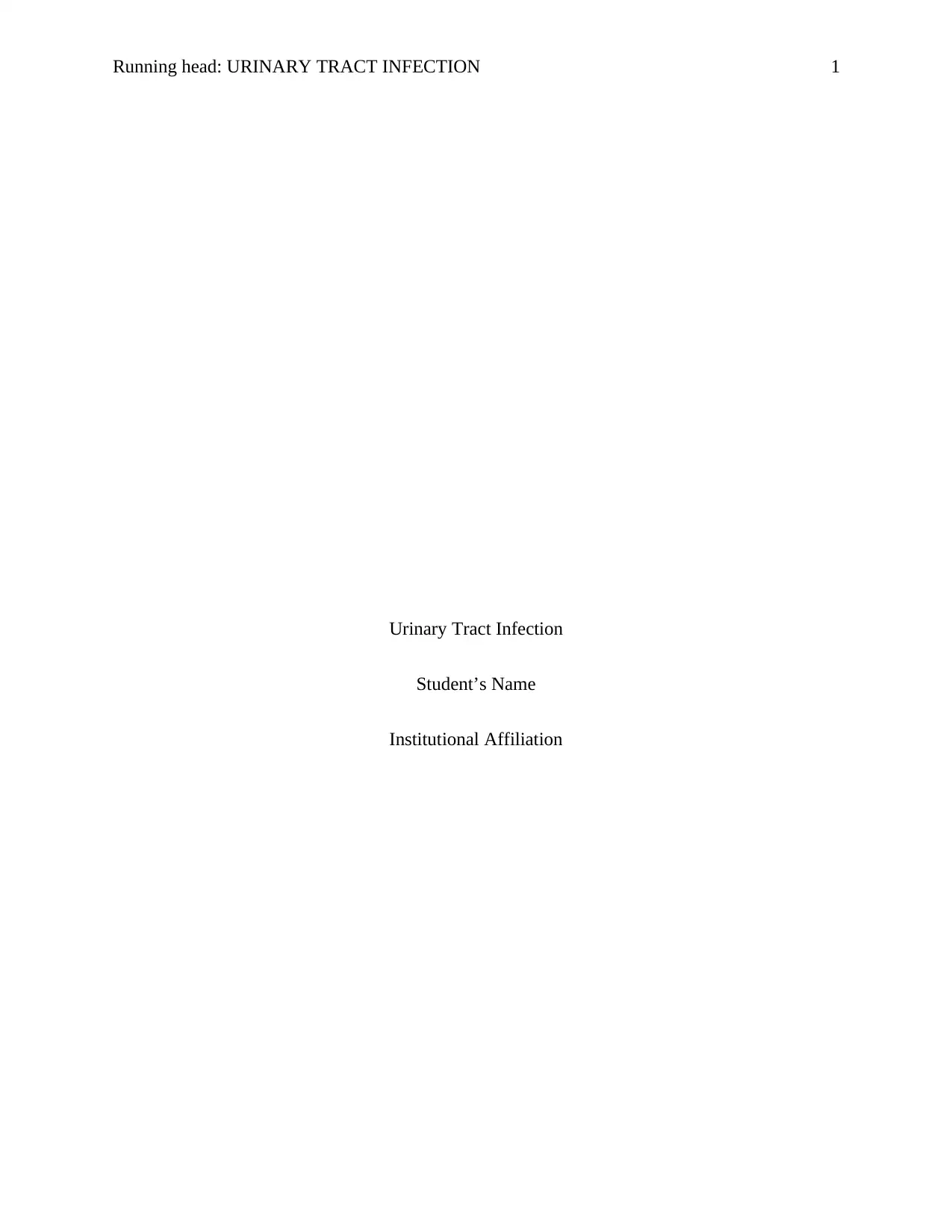
Running head: URINARY TRACT INFECTION 1
Urinary Tract Infection
Student’s Name
Institutional Affiliation
Urinary Tract Infection
Student’s Name
Institutional Affiliation
Paraphrase This Document
Need a fresh take? Get an instant paraphrase of this document with our AI Paraphraser
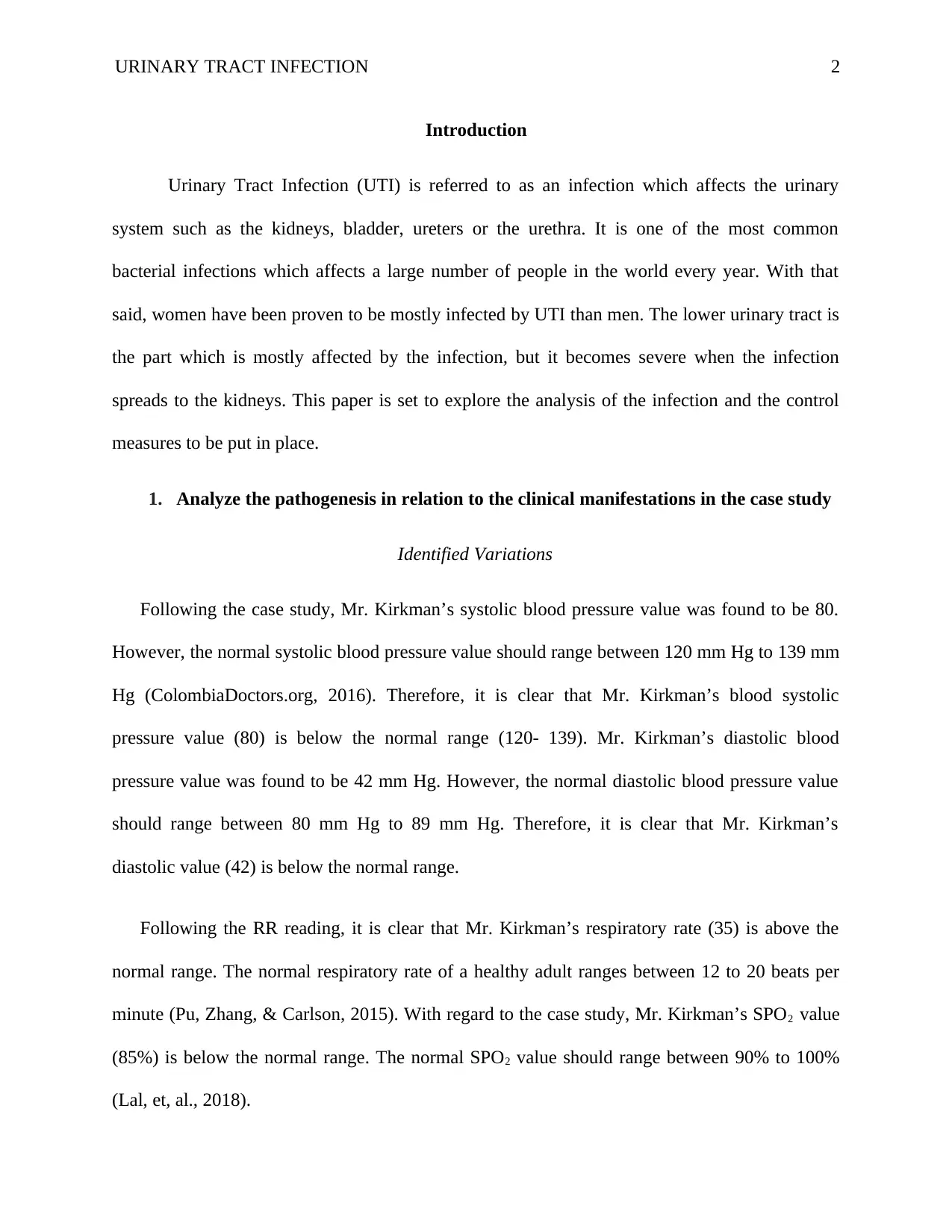
URINARY TRACT INFECTION 2
Introduction
Urinary Tract Infection (UTI) is referred to as an infection which affects the urinary
system such as the kidneys, bladder, ureters or the urethra. It is one of the most common
bacterial infections which affects a large number of people in the world every year. With that
said, women have been proven to be mostly infected by UTI than men. The lower urinary tract is
the part which is mostly affected by the infection, but it becomes severe when the infection
spreads to the kidneys. This paper is set to explore the analysis of the infection and the control
measures to be put in place.
1. Analyze the pathogenesis in relation to the clinical manifestations in the case study
Identified Variations
Following the case study, Mr. Kirkman’s systolic blood pressure value was found to be 80.
However, the normal systolic blood pressure value should range between 120 mm Hg to 139 mm
Hg (ColombiaDoctors.org, 2016). Therefore, it is clear that Mr. Kirkman’s blood systolic
pressure value (80) is below the normal range (120- 139). Mr. Kirkman’s diastolic blood
pressure value was found to be 42 mm Hg. However, the normal diastolic blood pressure value
should range between 80 mm Hg to 89 mm Hg. Therefore, it is clear that Mr. Kirkman’s
diastolic value (42) is below the normal range.
Following the RR reading, it is clear that Mr. Kirkman’s respiratory rate (35) is above the
normal range. The normal respiratory rate of a healthy adult ranges between 12 to 20 beats per
minute (Pu, Zhang, & Carlson, 2015). With regard to the case study, Mr. Kirkman’s SPO2 value
(85%) is below the normal range. The normal SPO2 value should range between 90% to 100%
(Lal, et, al., 2018).
Introduction
Urinary Tract Infection (UTI) is referred to as an infection which affects the urinary
system such as the kidneys, bladder, ureters or the urethra. It is one of the most common
bacterial infections which affects a large number of people in the world every year. With that
said, women have been proven to be mostly infected by UTI than men. The lower urinary tract is
the part which is mostly affected by the infection, but it becomes severe when the infection
spreads to the kidneys. This paper is set to explore the analysis of the infection and the control
measures to be put in place.
1. Analyze the pathogenesis in relation to the clinical manifestations in the case study
Identified Variations
Following the case study, Mr. Kirkman’s systolic blood pressure value was found to be 80.
However, the normal systolic blood pressure value should range between 120 mm Hg to 139 mm
Hg (ColombiaDoctors.org, 2016). Therefore, it is clear that Mr. Kirkman’s blood systolic
pressure value (80) is below the normal range (120- 139). Mr. Kirkman’s diastolic blood
pressure value was found to be 42 mm Hg. However, the normal diastolic blood pressure value
should range between 80 mm Hg to 89 mm Hg. Therefore, it is clear that Mr. Kirkman’s
diastolic value (42) is below the normal range.
Following the RR reading, it is clear that Mr. Kirkman’s respiratory rate (35) is above the
normal range. The normal respiratory rate of a healthy adult ranges between 12 to 20 beats per
minute (Pu, Zhang, & Carlson, 2015). With regard to the case study, Mr. Kirkman’s SPO2 value
(85%) is below the normal range. The normal SPO2 value should range between 90% to 100%
(Lal, et, al., 2018).
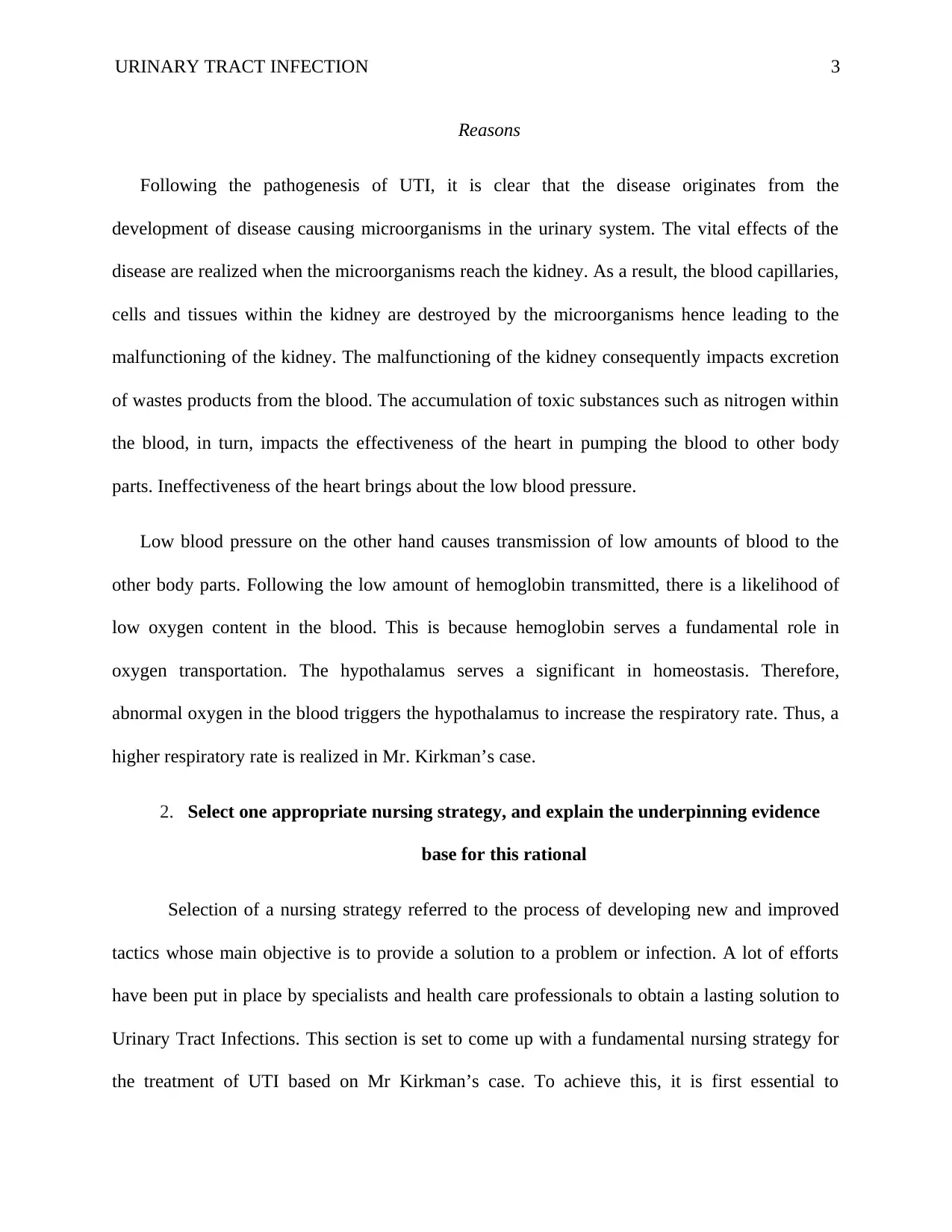
URINARY TRACT INFECTION 3
Reasons
Following the pathogenesis of UTI, it is clear that the disease originates from the
development of disease causing microorganisms in the urinary system. The vital effects of the
disease are realized when the microorganisms reach the kidney. As a result, the blood capillaries,
cells and tissues within the kidney are destroyed by the microorganisms hence leading to the
malfunctioning of the kidney. The malfunctioning of the kidney consequently impacts excretion
of wastes products from the blood. The accumulation of toxic substances such as nitrogen within
the blood, in turn, impacts the effectiveness of the heart in pumping the blood to other body
parts. Ineffectiveness of the heart brings about the low blood pressure.
Low blood pressure on the other hand causes transmission of low amounts of blood to the
other body parts. Following the low amount of hemoglobin transmitted, there is a likelihood of
low oxygen content in the blood. This is because hemoglobin serves a fundamental role in
oxygen transportation. The hypothalamus serves a significant in homeostasis. Therefore,
abnormal oxygen in the blood triggers the hypothalamus to increase the respiratory rate. Thus, a
higher respiratory rate is realized in Mr. Kirkman’s case.
2. Select one appropriate nursing strategy, and explain the underpinning evidence
base for this rational
Selection of a nursing strategy referred to the process of developing new and improved
tactics whose main objective is to provide a solution to a problem or infection. A lot of efforts
have been put in place by specialists and health care professionals to obtain a lasting solution to
Urinary Tract Infections. This section is set to come up with a fundamental nursing strategy for
the treatment of UTI based on Mr Kirkman’s case. To achieve this, it is first essential to
Reasons
Following the pathogenesis of UTI, it is clear that the disease originates from the
development of disease causing microorganisms in the urinary system. The vital effects of the
disease are realized when the microorganisms reach the kidney. As a result, the blood capillaries,
cells and tissues within the kidney are destroyed by the microorganisms hence leading to the
malfunctioning of the kidney. The malfunctioning of the kidney consequently impacts excretion
of wastes products from the blood. The accumulation of toxic substances such as nitrogen within
the blood, in turn, impacts the effectiveness of the heart in pumping the blood to other body
parts. Ineffectiveness of the heart brings about the low blood pressure.
Low blood pressure on the other hand causes transmission of low amounts of blood to the
other body parts. Following the low amount of hemoglobin transmitted, there is a likelihood of
low oxygen content in the blood. This is because hemoglobin serves a fundamental role in
oxygen transportation. The hypothalamus serves a significant in homeostasis. Therefore,
abnormal oxygen in the blood triggers the hypothalamus to increase the respiratory rate. Thus, a
higher respiratory rate is realized in Mr. Kirkman’s case.
2. Select one appropriate nursing strategy, and explain the underpinning evidence
base for this rational
Selection of a nursing strategy referred to the process of developing new and improved
tactics whose main objective is to provide a solution to a problem or infection. A lot of efforts
have been put in place by specialists and health care professionals to obtain a lasting solution to
Urinary Tract Infections. This section is set to come up with a fundamental nursing strategy for
the treatment of UTI based on Mr Kirkman’s case. To achieve this, it is first essential to
⊘ This is a preview!⊘
Do you want full access?
Subscribe today to unlock all pages.

Trusted by 1+ million students worldwide
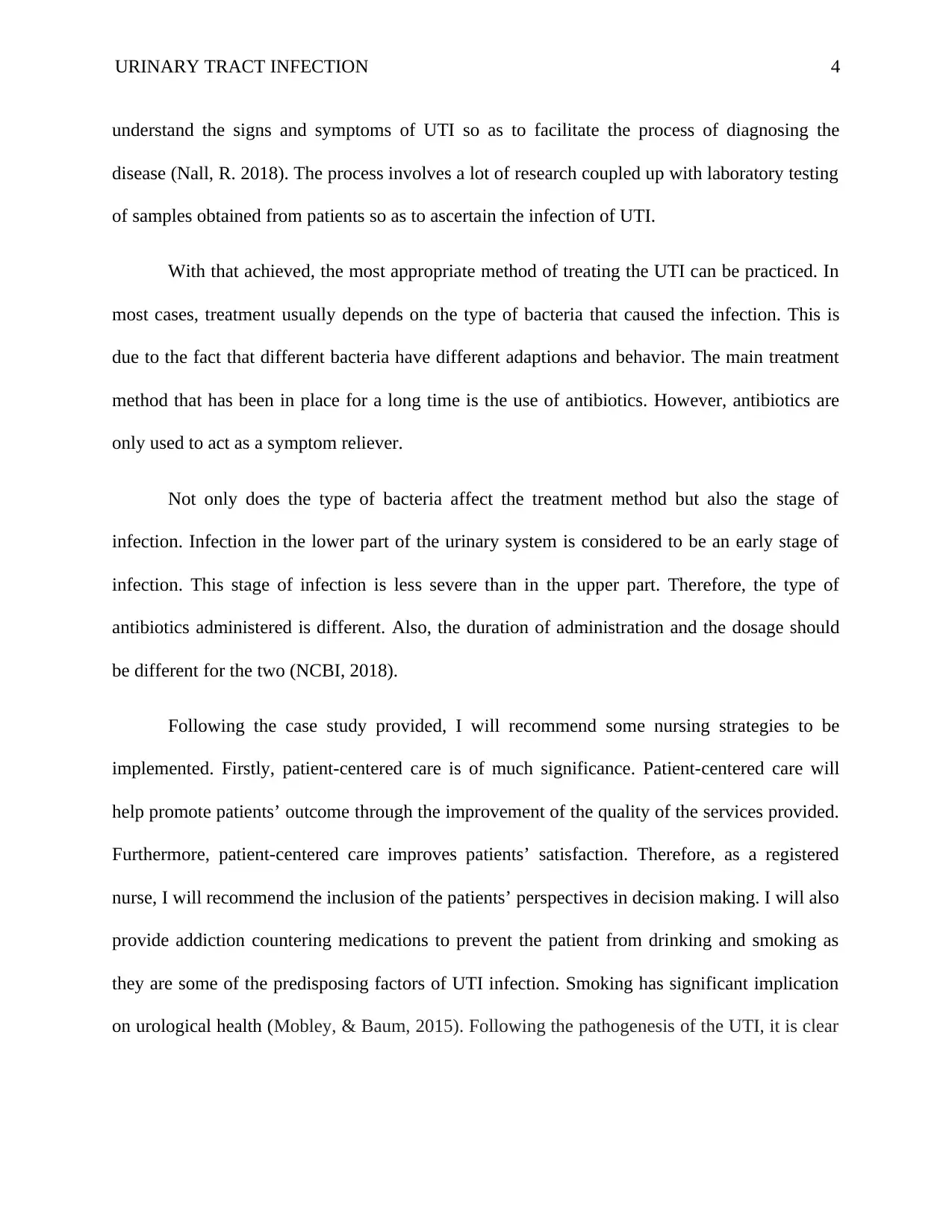
URINARY TRACT INFECTION 4
understand the signs and symptoms of UTI so as to facilitate the process of diagnosing the
disease (Nall, R. 2018). The process involves a lot of research coupled up with laboratory testing
of samples obtained from patients so as to ascertain the infection of UTI.
With that achieved, the most appropriate method of treating the UTI can be practiced. In
most cases, treatment usually depends on the type of bacteria that caused the infection. This is
due to the fact that different bacteria have different adaptions and behavior. The main treatment
method that has been in place for a long time is the use of antibiotics. However, antibiotics are
only used to act as a symptom reliever.
Not only does the type of bacteria affect the treatment method but also the stage of
infection. Infection in the lower part of the urinary system is considered to be an early stage of
infection. This stage of infection is less severe than in the upper part. Therefore, the type of
antibiotics administered is different. Also, the duration of administration and the dosage should
be different for the two (NCBI, 2018).
Following the case study provided, I will recommend some nursing strategies to be
implemented. Firstly, patient-centered care is of much significance. Patient-centered care will
help promote patients’ outcome through the improvement of the quality of the services provided.
Furthermore, patient-centered care improves patients’ satisfaction. Therefore, as a registered
nurse, I will recommend the inclusion of the patients’ perspectives in decision making. I will also
provide addiction countering medications to prevent the patient from drinking and smoking as
they are some of the predisposing factors of UTI infection. Smoking has significant implication
on urological health (Mobley, & Baum, 2015). Following the pathogenesis of the UTI, it is clear
understand the signs and symptoms of UTI so as to facilitate the process of diagnosing the
disease (Nall, R. 2018). The process involves a lot of research coupled up with laboratory testing
of samples obtained from patients so as to ascertain the infection of UTI.
With that achieved, the most appropriate method of treating the UTI can be practiced. In
most cases, treatment usually depends on the type of bacteria that caused the infection. This is
due to the fact that different bacteria have different adaptions and behavior. The main treatment
method that has been in place for a long time is the use of antibiotics. However, antibiotics are
only used to act as a symptom reliever.
Not only does the type of bacteria affect the treatment method but also the stage of
infection. Infection in the lower part of the urinary system is considered to be an early stage of
infection. This stage of infection is less severe than in the upper part. Therefore, the type of
antibiotics administered is different. Also, the duration of administration and the dosage should
be different for the two (NCBI, 2018).
Following the case study provided, I will recommend some nursing strategies to be
implemented. Firstly, patient-centered care is of much significance. Patient-centered care will
help promote patients’ outcome through the improvement of the quality of the services provided.
Furthermore, patient-centered care improves patients’ satisfaction. Therefore, as a registered
nurse, I will recommend the inclusion of the patients’ perspectives in decision making. I will also
provide addiction countering medications to prevent the patient from drinking and smoking as
they are some of the predisposing factors of UTI infection. Smoking has significant implication
on urological health (Mobley, & Baum, 2015). Following the pathogenesis of the UTI, it is clear
Paraphrase This Document
Need a fresh take? Get an instant paraphrase of this document with our AI Paraphraser
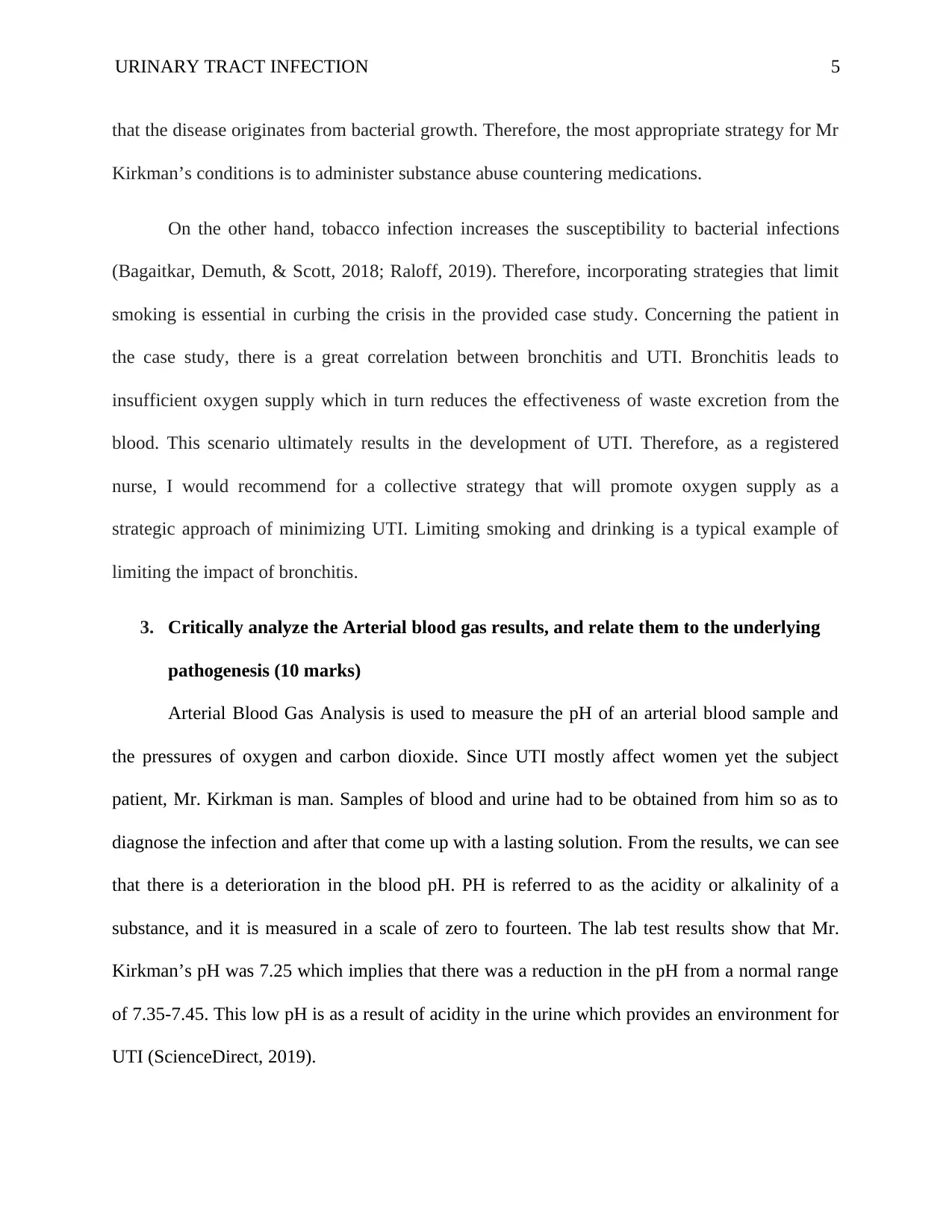
URINARY TRACT INFECTION 5
that the disease originates from bacterial growth. Therefore, the most appropriate strategy for Mr
Kirkman’s conditions is to administer substance abuse countering medications.
On the other hand, tobacco infection increases the susceptibility to bacterial infections
(Bagaitkar, Demuth, & Scott, 2018; Raloff, 2019). Therefore, incorporating strategies that limit
smoking is essential in curbing the crisis in the provided case study. Concerning the patient in
the case study, there is a great correlation between bronchitis and UTI. Bronchitis leads to
insufficient oxygen supply which in turn reduces the effectiveness of waste excretion from the
blood. This scenario ultimately results in the development of UTI. Therefore, as a registered
nurse, I would recommend for a collective strategy that will promote oxygen supply as a
strategic approach of minimizing UTI. Limiting smoking and drinking is a typical example of
limiting the impact of bronchitis.
3. Critically analyze the Arterial blood gas results, and relate them to the underlying
pathogenesis (10 marks)
Arterial Blood Gas Analysis is used to measure the pH of an arterial blood sample and
the pressures of oxygen and carbon dioxide. Since UTI mostly affect women yet the subject
patient, Mr. Kirkman is man. Samples of blood and urine had to be obtained from him so as to
diagnose the infection and after that come up with a lasting solution. From the results, we can see
that there is a deterioration in the blood pH. PH is referred to as the acidity or alkalinity of a
substance, and it is measured in a scale of zero to fourteen. The lab test results show that Mr.
Kirkman’s pH was 7.25 which implies that there was a reduction in the pH from a normal range
of 7.35-7.45. This low pH is as a result of acidity in the urine which provides an environment for
UTI (ScienceDirect, 2019).
that the disease originates from bacterial growth. Therefore, the most appropriate strategy for Mr
Kirkman’s conditions is to administer substance abuse countering medications.
On the other hand, tobacco infection increases the susceptibility to bacterial infections
(Bagaitkar, Demuth, & Scott, 2018; Raloff, 2019). Therefore, incorporating strategies that limit
smoking is essential in curbing the crisis in the provided case study. Concerning the patient in
the case study, there is a great correlation between bronchitis and UTI. Bronchitis leads to
insufficient oxygen supply which in turn reduces the effectiveness of waste excretion from the
blood. This scenario ultimately results in the development of UTI. Therefore, as a registered
nurse, I would recommend for a collective strategy that will promote oxygen supply as a
strategic approach of minimizing UTI. Limiting smoking and drinking is a typical example of
limiting the impact of bronchitis.
3. Critically analyze the Arterial blood gas results, and relate them to the underlying
pathogenesis (10 marks)
Arterial Blood Gas Analysis is used to measure the pH of an arterial blood sample and
the pressures of oxygen and carbon dioxide. Since UTI mostly affect women yet the subject
patient, Mr. Kirkman is man. Samples of blood and urine had to be obtained from him so as to
diagnose the infection and after that come up with a lasting solution. From the results, we can see
that there is a deterioration in the blood pH. PH is referred to as the acidity or alkalinity of a
substance, and it is measured in a scale of zero to fourteen. The lab test results show that Mr.
Kirkman’s pH was 7.25 which implies that there was a reduction in the pH from a normal range
of 7.35-7.45. This low pH is as a result of acidity in the urine which provides an environment for
UTI (ScienceDirect, 2019).
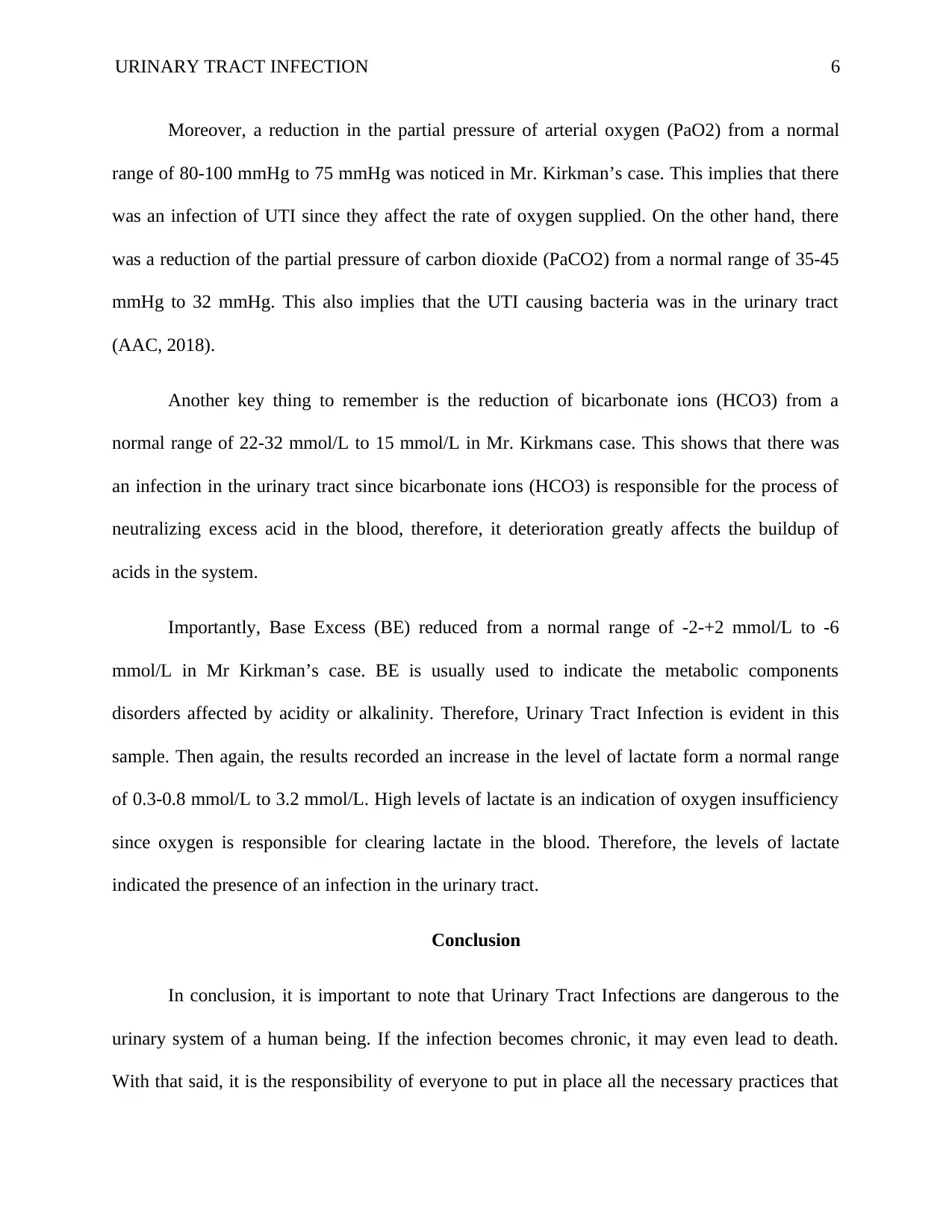
URINARY TRACT INFECTION 6
Moreover, a reduction in the partial pressure of arterial oxygen (PaO2) from a normal
range of 80-100 mmHg to 75 mmHg was noticed in Mr. Kirkman’s case. This implies that there
was an infection of UTI since they affect the rate of oxygen supplied. On the other hand, there
was a reduction of the partial pressure of carbon dioxide (PaCO2) from a normal range of 35-45
mmHg to 32 mmHg. This also implies that the UTI causing bacteria was in the urinary tract
(AAC, 2018).
Another key thing to remember is the reduction of bicarbonate ions (HCO3) from a
normal range of 22-32 mmol/L to 15 mmol/L in Mr. Kirkmans case. This shows that there was
an infection in the urinary tract since bicarbonate ions (HCO3) is responsible for the process of
neutralizing excess acid in the blood, therefore, it deterioration greatly affects the buildup of
acids in the system.
Importantly, Base Excess (BE) reduced from a normal range of -2-+2 mmol/L to -6
mmol/L in Mr Kirkman’s case. BE is usually used to indicate the metabolic components
disorders affected by acidity or alkalinity. Therefore, Urinary Tract Infection is evident in this
sample. Then again, the results recorded an increase in the level of lactate form a normal range
of 0.3-0.8 mmol/L to 3.2 mmol/L. High levels of lactate is an indication of oxygen insufficiency
since oxygen is responsible for clearing lactate in the blood. Therefore, the levels of lactate
indicated the presence of an infection in the urinary tract.
Conclusion
In conclusion, it is important to note that Urinary Tract Infections are dangerous to the
urinary system of a human being. If the infection becomes chronic, it may even lead to death.
With that said, it is the responsibility of everyone to put in place all the necessary practices that
Moreover, a reduction in the partial pressure of arterial oxygen (PaO2) from a normal
range of 80-100 mmHg to 75 mmHg was noticed in Mr. Kirkman’s case. This implies that there
was an infection of UTI since they affect the rate of oxygen supplied. On the other hand, there
was a reduction of the partial pressure of carbon dioxide (PaCO2) from a normal range of 35-45
mmHg to 32 mmHg. This also implies that the UTI causing bacteria was in the urinary tract
(AAC, 2018).
Another key thing to remember is the reduction of bicarbonate ions (HCO3) from a
normal range of 22-32 mmol/L to 15 mmol/L in Mr. Kirkmans case. This shows that there was
an infection in the urinary tract since bicarbonate ions (HCO3) is responsible for the process of
neutralizing excess acid in the blood, therefore, it deterioration greatly affects the buildup of
acids in the system.
Importantly, Base Excess (BE) reduced from a normal range of -2-+2 mmol/L to -6
mmol/L in Mr Kirkman’s case. BE is usually used to indicate the metabolic components
disorders affected by acidity or alkalinity. Therefore, Urinary Tract Infection is evident in this
sample. Then again, the results recorded an increase in the level of lactate form a normal range
of 0.3-0.8 mmol/L to 3.2 mmol/L. High levels of lactate is an indication of oxygen insufficiency
since oxygen is responsible for clearing lactate in the blood. Therefore, the levels of lactate
indicated the presence of an infection in the urinary tract.
Conclusion
In conclusion, it is important to note that Urinary Tract Infections are dangerous to the
urinary system of a human being. If the infection becomes chronic, it may even lead to death.
With that said, it is the responsibility of everyone to put in place all the necessary practices that
⊘ This is a preview!⊘
Do you want full access?
Subscribe today to unlock all pages.

Trusted by 1+ million students worldwide
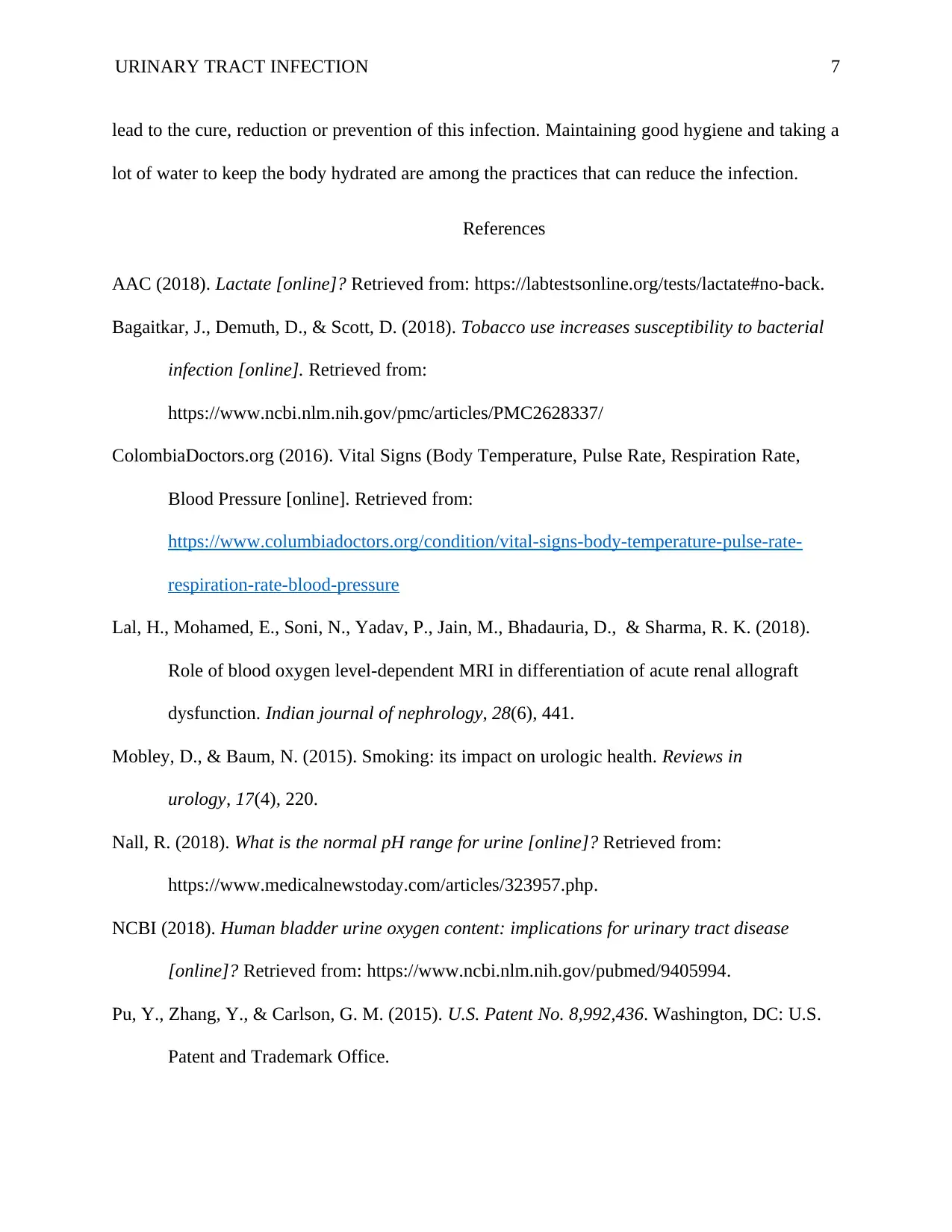
URINARY TRACT INFECTION 7
lead to the cure, reduction or prevention of this infection. Maintaining good hygiene and taking a
lot of water to keep the body hydrated are among the practices that can reduce the infection.
References
AAC (2018). Lactate [online]? Retrieved from: https://labtestsonline.org/tests/lactate#no-back.
Bagaitkar, J., Demuth, D., & Scott, D. (2018). Tobacco use increases susceptibility to bacterial
infection [online]. Retrieved from:
https://www.ncbi.nlm.nih.gov/pmc/articles/PMC2628337/
ColombiaDoctors.org (2016). Vital Signs (Body Temperature, Pulse Rate, Respiration Rate,
Blood Pressure [online]. Retrieved from:
https://www.columbiadoctors.org/condition/vital-signs-body-temperature-pulse-rate-
respiration-rate-blood-pressure
Lal, H., Mohamed, E., Soni, N., Yadav, P., Jain, M., Bhadauria, D., & Sharma, R. K. (2018).
Role of blood oxygen level-dependent MRI in differentiation of acute renal allograft
dysfunction. Indian journal of nephrology, 28(6), 441.
Mobley, D., & Baum, N. (2015). Smoking: its impact on urologic health. Reviews in
urology, 17(4), 220.
Nall, R. (2018). What is the normal pH range for urine [online]? Retrieved from:
https://www.medicalnewstoday.com/articles/323957.php.
NCBI (2018). Human bladder urine oxygen content: implications for urinary tract disease
[online]? Retrieved from: https://www.ncbi.nlm.nih.gov/pubmed/9405994.
Pu, Y., Zhang, Y., & Carlson, G. M. (2015). U.S. Patent No. 8,992,436. Washington, DC: U.S.
Patent and Trademark Office.
lead to the cure, reduction or prevention of this infection. Maintaining good hygiene and taking a
lot of water to keep the body hydrated are among the practices that can reduce the infection.
References
AAC (2018). Lactate [online]? Retrieved from: https://labtestsonline.org/tests/lactate#no-back.
Bagaitkar, J., Demuth, D., & Scott, D. (2018). Tobacco use increases susceptibility to bacterial
infection [online]. Retrieved from:
https://www.ncbi.nlm.nih.gov/pmc/articles/PMC2628337/
ColombiaDoctors.org (2016). Vital Signs (Body Temperature, Pulse Rate, Respiration Rate,
Blood Pressure [online]. Retrieved from:
https://www.columbiadoctors.org/condition/vital-signs-body-temperature-pulse-rate-
respiration-rate-blood-pressure
Lal, H., Mohamed, E., Soni, N., Yadav, P., Jain, M., Bhadauria, D., & Sharma, R. K. (2018).
Role of blood oxygen level-dependent MRI in differentiation of acute renal allograft
dysfunction. Indian journal of nephrology, 28(6), 441.
Mobley, D., & Baum, N. (2015). Smoking: its impact on urologic health. Reviews in
urology, 17(4), 220.
Nall, R. (2018). What is the normal pH range for urine [online]? Retrieved from:
https://www.medicalnewstoday.com/articles/323957.php.
NCBI (2018). Human bladder urine oxygen content: implications for urinary tract disease
[online]? Retrieved from: https://www.ncbi.nlm.nih.gov/pubmed/9405994.
Pu, Y., Zhang, Y., & Carlson, G. M. (2015). U.S. Patent No. 8,992,436. Washington, DC: U.S.
Patent and Trademark Office.
Paraphrase This Document
Need a fresh take? Get an instant paraphrase of this document with our AI Paraphraser
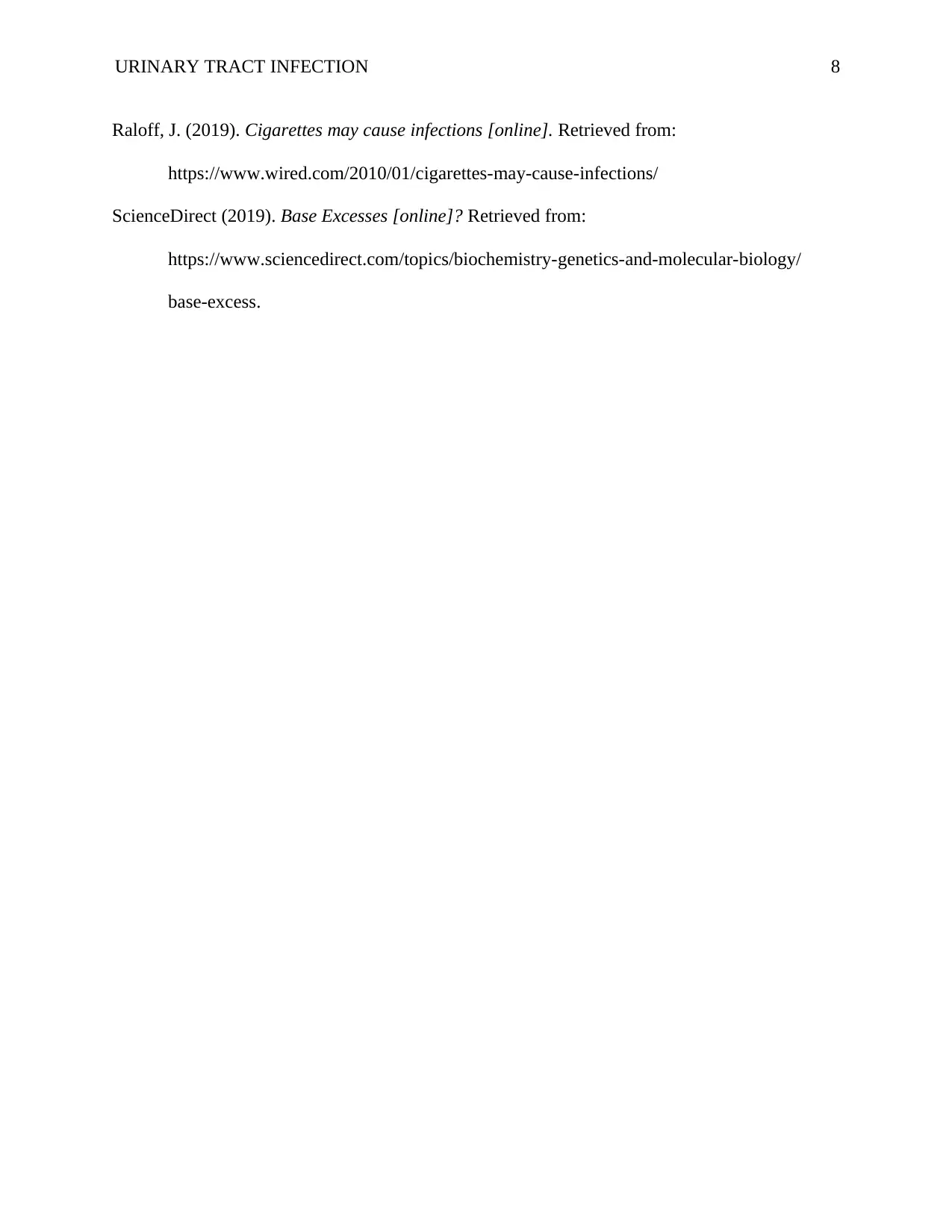
URINARY TRACT INFECTION 8
Raloff, J. (2019). Cigarettes may cause infections [online]. Retrieved from:
https://www.wired.com/2010/01/cigarettes-may-cause-infections/
ScienceDirect (2019). Base Excesses [online]? Retrieved from:
https://www.sciencedirect.com/topics/biochemistry-genetics-and-molecular-biology/
base-excess.
Raloff, J. (2019). Cigarettes may cause infections [online]. Retrieved from:
https://www.wired.com/2010/01/cigarettes-may-cause-infections/
ScienceDirect (2019). Base Excesses [online]? Retrieved from:
https://www.sciencedirect.com/topics/biochemistry-genetics-and-molecular-biology/
base-excess.
1 out of 8
Related Documents
Your All-in-One AI-Powered Toolkit for Academic Success.
+13062052269
info@desklib.com
Available 24*7 on WhatsApp / Email
![[object Object]](/_next/static/media/star-bottom.7253800d.svg)
Unlock your academic potential
Copyright © 2020–2025 A2Z Services. All Rights Reserved. Developed and managed by ZUCOL.





